Key takeaways:
- Clear communication and regular check-ins are essential for maintaining team morale and alignment in remote agile environments.
- Embracing flexibility and adaptability helps teams navigate unexpected challenges and capitalize on change.
- Effective use of collaboration tools and virtual team-building activities enhances creativity, engagement, and relationships among remote team members.
- Transparency in communication fosters trust and encourages a supportive atmosphere within the team.
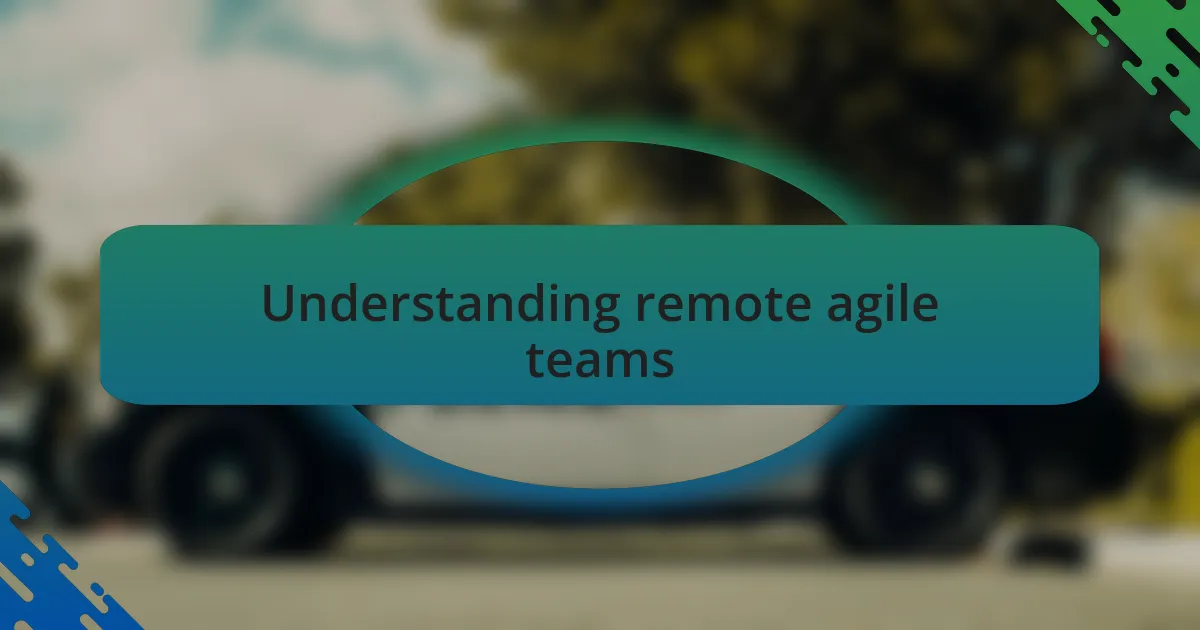
Understanding remote agile teams
Remote agile teams operate on the same core principles as traditional agile teams but with the added complexity of physical separation. I recall a project where my team was spread across three different time zones. This experience taught me the importance of clear communication; I found that syncing our daily stand-ups was crucial for maintaining team morale and ensuring everyone felt included, even if we weren’t in the same room.
The dynamic nature of agile methodologies really shines in a remote setting. I vividly remember a sprint planning session where, despite our geographic differences, we were able to use collaborative tools to brainstorm and prioritize tasks seamlessly. It was fascinating to witness how technology fosters creativity and inclusivity, making it feel like we were working side by side rather than miles apart.
Embracing flexibility is vital in understanding remote agile teams. I’ve had my share of unexpected challenges—like a sudden thunderstorm that knocked out power and internet for a few team members. During times like these, it helps to cultivate a culture of empathy and adaptability, reminding ourselves that while we strive for progress, life will always throw us curveballs. How we respond in these moments can make or break our team dynamics.
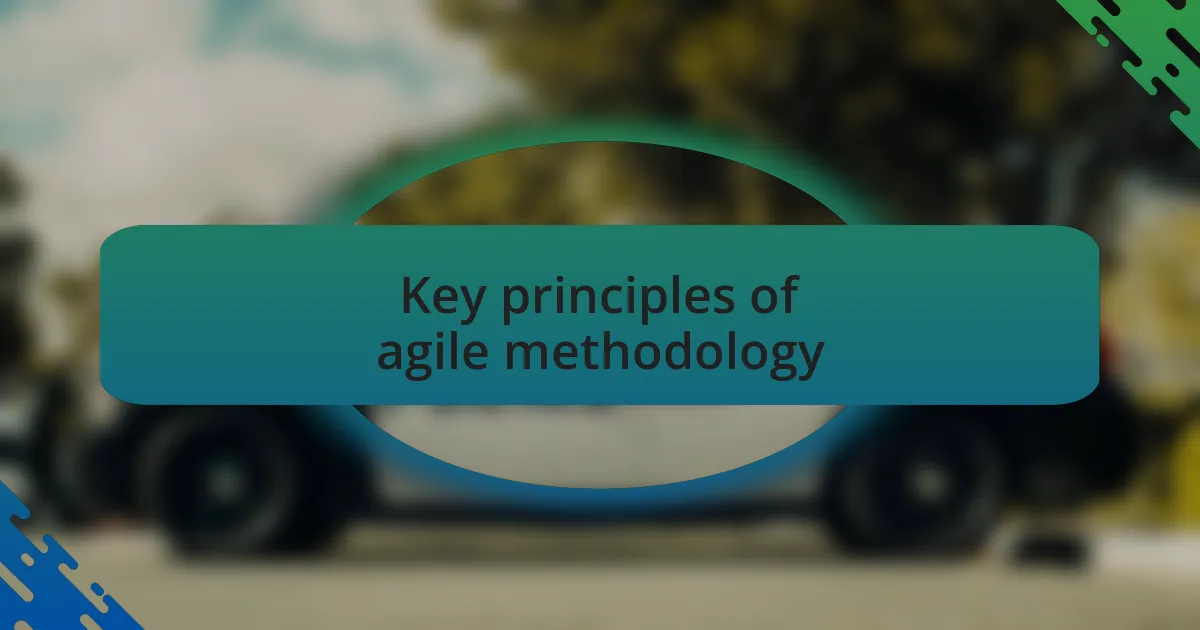
Key principles of agile methodology
Agile methodology is built on key principles that prioritize collaboration, flexibility, and customer value. One principle I’ve always found encouraging is the emphasis on individuals and interactions over processes and tools. I once led a project where we replaced a complicated tracking tool with simple daily check-ins and found it immensely refreshing. The energy from those conversations not only boosted our productivity but also strengthened our team bond. Have you ever noticed how a quick chat can resolve what countless emails might complicate?
Another foundational aspect is delivering working software frequently, which I believe maintains both momentum and motivation. In one project, we adapted our release strategy to deliver smaller features bi-weekly. I watched the team’s excitement grow after each deployment, fueled by feedback that guided our next iterations. This approach not only kept us aligned with customer expectations but also reinforced the belief that small successes lead to greater achievements. Isn’t it incredible how regular feedback can transform a project’s direction?
Lastly, the principle of responding to change rather than following a plan has been pivotal in my experience with agile teams. I recall a scenario where a major client request changed the entire scope of our project. Instead of panicking, we embraced this shift; it allowed us to innovate and refine our solution. This adaptability can be challenging but reminds us that flexibility often opens doors to unexpected opportunities. How do you approach change when it arises in your projects?
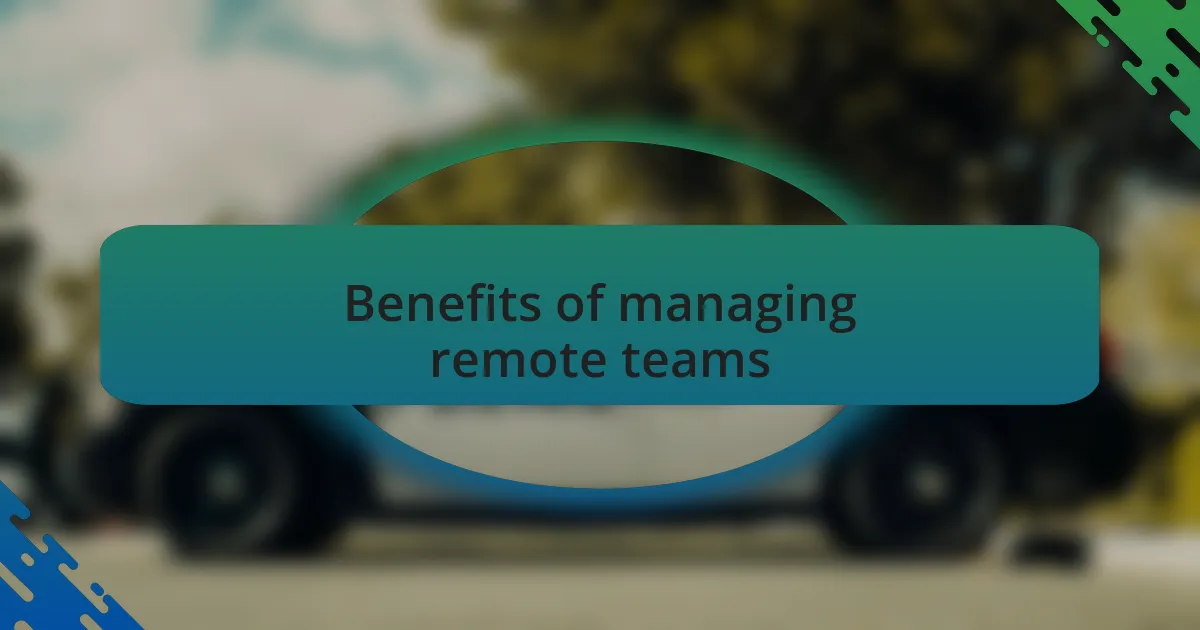
Benefits of managing remote teams
Managing remote teams has several distinct benefits that enhance both performance and morale. One of the most significant advantages I’ve experienced is the ability to tap into a global talent pool. In a recent project, I was fortunate to assemble a team from diverse backgrounds and expertise, which enriched our problem-solving capabilities. Isn’t it eye-opening to see how different perspectives drive creativity and lead to innovative solutions?
Another benefit I noticed is the flexibility that remote work fosters. Team members can often choose their optimal working hours, leading to increased productivity. I remember a colleague who thrived in the quiet hours of the early morning. By aligning work with individual productivity patterns, we all benefited from heightened focus and efficiency. Have you seen how such arrangements can transform a team’s output?
Furthermore, remote work often leads to higher job satisfaction among team members. I noticed how the absence of a daily commute allowed my team to enjoy a better work-life balance. This shift not only reduced burnout but also fostered a more positive and engaged workforce. Isn’t it amazing how small changes, like working from home, can have a profound impact on team dynamics?
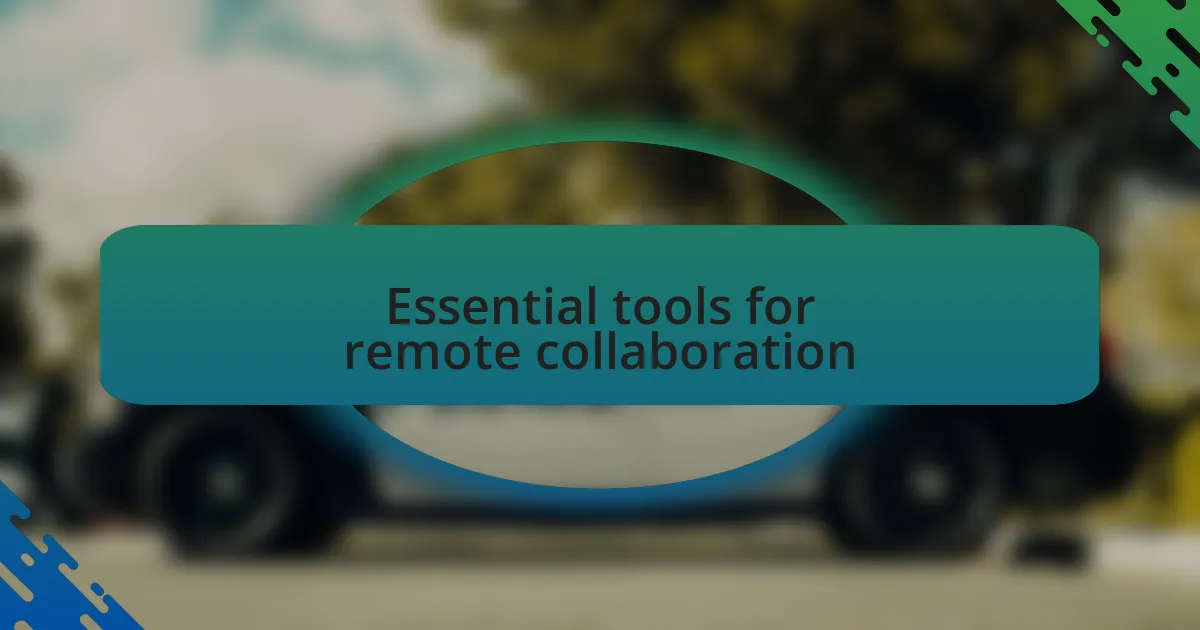
Essential tools for remote collaboration
Effective remote collaboration relies heavily on the right tools. I’ve found that platforms like Slack and Microsoft Teams create a virtual water cooler effect where ideas flow freely. Have you ever noticed how those casual chats can spark innovation? It’s like having an office environment where spontaneous brainstorming leads to breakthroughs, even from behind a screen.
For project management, I swear by Trello and Jira. Using these tools, I can visually track ongoing tasks and deadlines with my team. In one project, our ability to see each task’s progress in real-time avoided the dreaded bottleneck scenarios. I remember a time when a last-minute change in priorities could have derailed us, but with Jira, we easily adapted and delivered on time. How crucial is it to maintain clarity in roles and responsibilities when everyone is working remotely?
Video conferencing tools like Zoom have been game-changers for my team’s dynamic. I once scheduled a bi-weekly ‘coffee catch-up’ that was purely social, which helped build rapport and trust among team members. The casual setup encouraged open dialogue, making our collaboration during work hours that much more effective. Isn’t it enriching to see how face-to-face interactions, even virtually, can enhance connectivity and camaraderie in a remote setting?
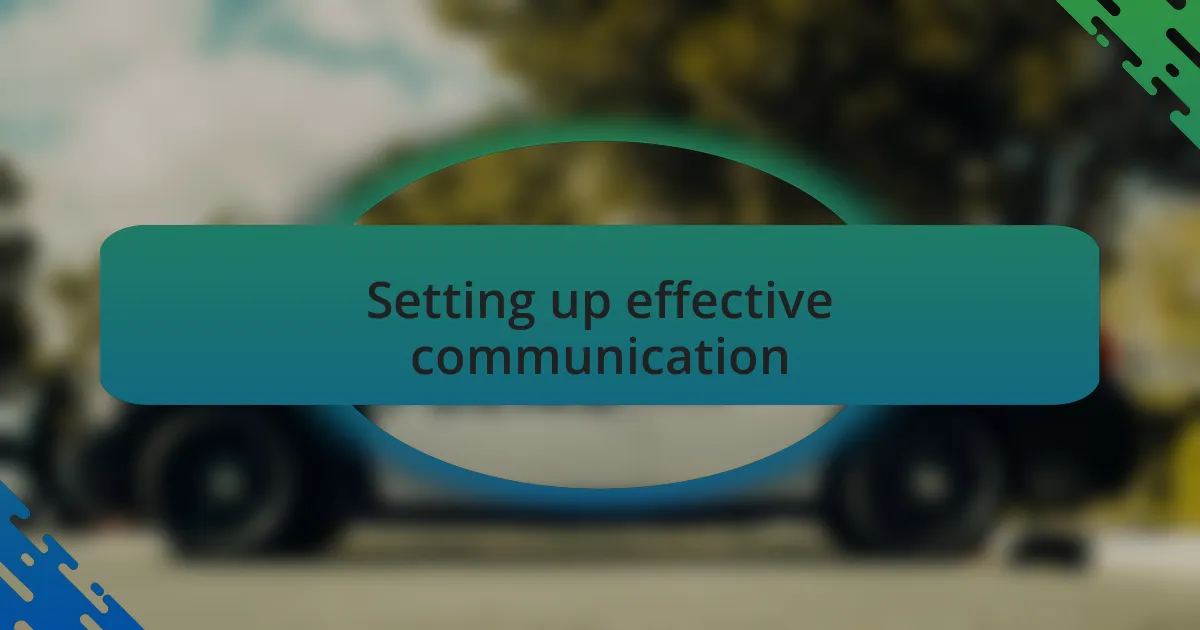
Setting up effective communication
Clear and consistent communication is the backbone of any successful remote Agile team. Early in my experience, I recognized that miscommunication could spiral into significant issues. I still remember a project where team members relied on emails alone; misunderstandings crept in and caused confusion over priorities. It made me realize that setting up regular check-ins through video calls significantly alleviated these problems by allowing us to address concerns in real-time.
One approach that worked remarkably well was implementing daily stand-ups. Initially, I was skeptical—could a quick catch-up really make a difference? However, I soon learned that even a brief 15-minute session could align our goals and clarify our focus for the day. Hearing everyone’s voice and challenges fosters a sense of unity, and it’s amazing how those few minutes sharpen everyone’s focus. Have you thought about how simple routines could transform your team dynamics?
I also embraced the power of transparency in communication. I encouraged team members to share updates openly on our project management tool. There was a moment when one of my developers faced a roadblock and hesitated to speak up. It struck me that fostering an environment where everyone feels safe to express their struggles is vital. I shared my own challenges to set a tone of vulnerability. This openness not only enhanced trust but also became a catalyst for collaboration, proving that effective communication goes beyond just words.
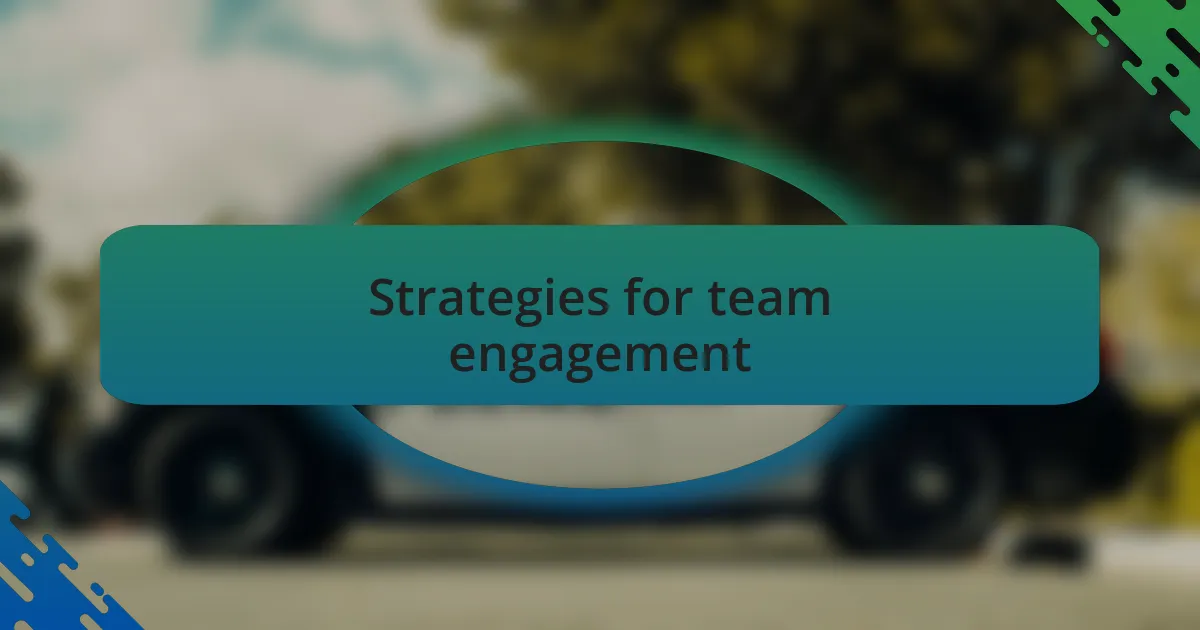
Strategies for team engagement
Engaging a remote Agile team requires a proactive and intentional approach. In my experience, introducing virtual team-building activities has significantly boosted morale and cohesion. I recall one memorable day when we organized an online trivia game; it was refreshing to watch everyone open up and enjoy themselves, breaking the usual work-related intensity. Have you ever noticed how these moments can spark creativity and strengthen relationships among team members?
Another effective strategy I’ve utilized is rotating leadership roles during collaborative sessions. This not only empowers each team member but also fosters a sense of ownership over projects. I still remember the first time I handed over the reins to a less vocal team member. The excitement in their voice transformed the dynamic of the meeting, invigorating discussions and encouraging contributions that I hadn’t seen before. Isn’t it fascinating how a shift in perspective can unlock potential?
Lastly, I’ve found that showing appreciation can go a long way in sustaining engagement. Recognizing individual contributions, whether through a shout-out in a team meeting or a simple message of thanks, creates a supportive atmosphere. One day, I took a moment to highlight the extra effort a team member put into their work; their reaction reminded me just how powerful acknowledgment can be. When was the last time you celebrated a small victory within your team? Those moments weave the fabric of connection that keeps remote teams thriving.
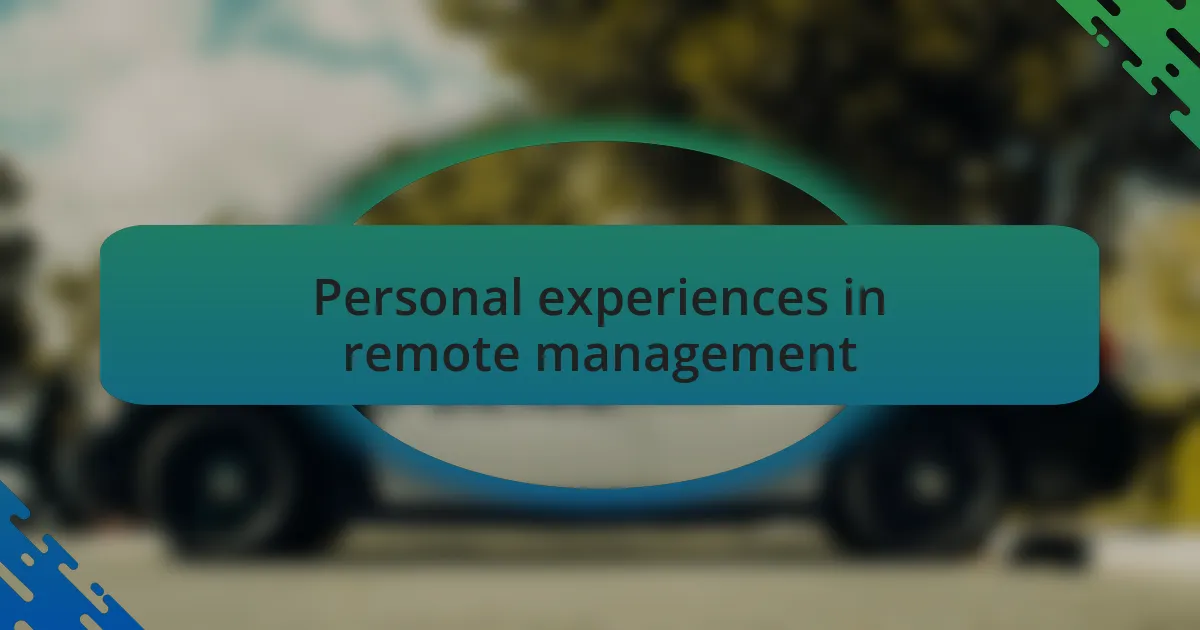
Personal experiences in remote management
Managing remote Agile teams has definitely shaped my approach to leadership. One experience that stands out was when I noticed a team member, usually quite reserved, seemed disengaged during meetings. Rather than addressing the issue head-on, I reached out privately and discovered they had been facing challenges with their workload. By offering support and adjusting their tasks, I witnessed a remarkable shift in their engagement and contributions—what a transformational moment!
In another instance, I started holding regular one-on-one check-ins to foster deeper relationships. During these sessions, I encouraged team members to share not only their work-related concerns but also their personal triumphs and struggles. I vividly recall one of these interactions, where a team member expressed their passion for a side project. Encouraging them to integrate insights from their work into our projects not only bolstered their morale but also enriched our overall output. Have you ever found that personal stories can lead to newfound collaboration opportunities?
I also realized that transparency is vital in remote settings. One week, I faced a significant project delay and made it a point to communicate openly with the entire team. Sharing the challenges and the steps we were taking to address them promoted trust and understanding. It was heartening to receive feedback from my team, letting me know that they appreciated the honesty and were more than willing to rally together during tough times. Have you experienced a moment where vulnerability has strengthened team bonds?